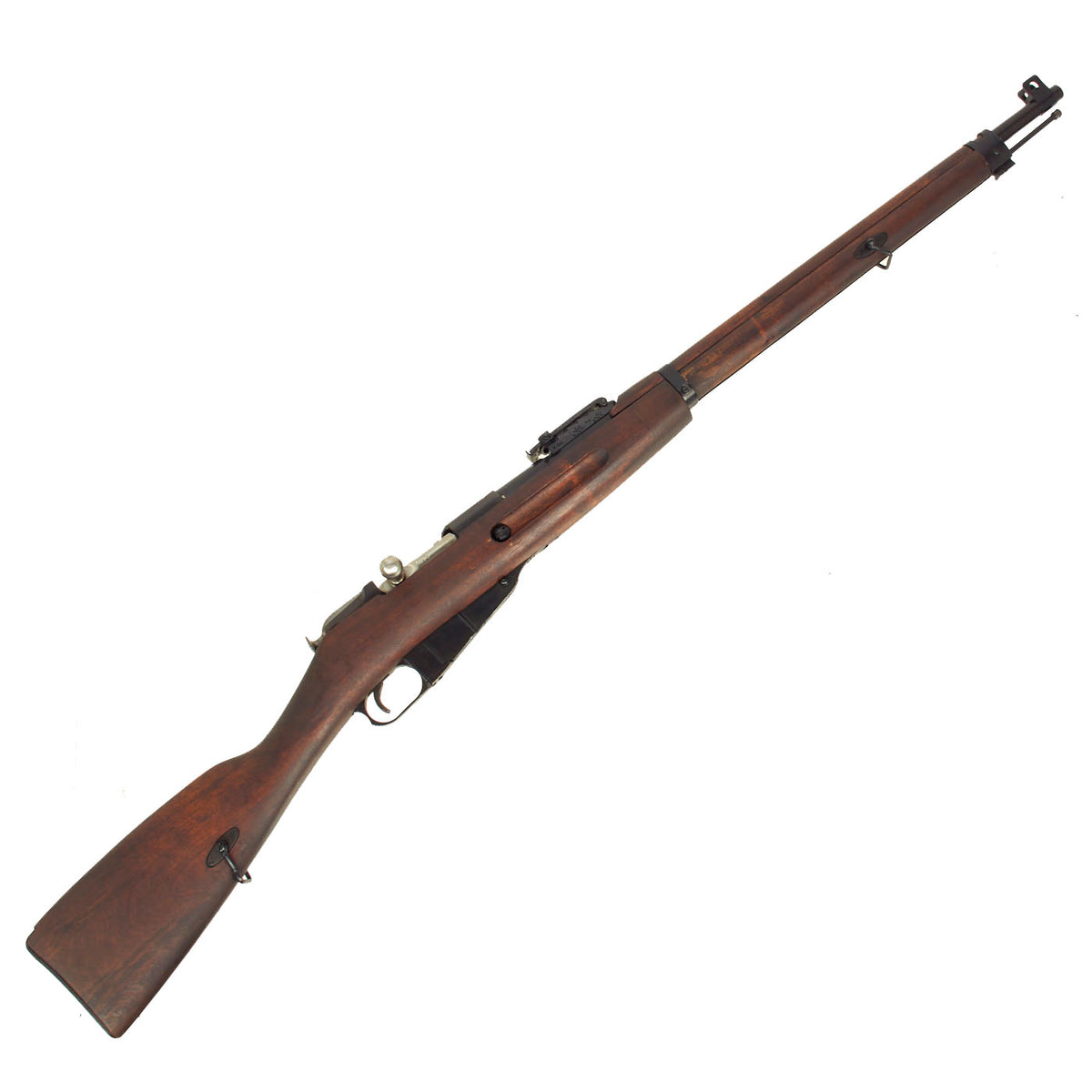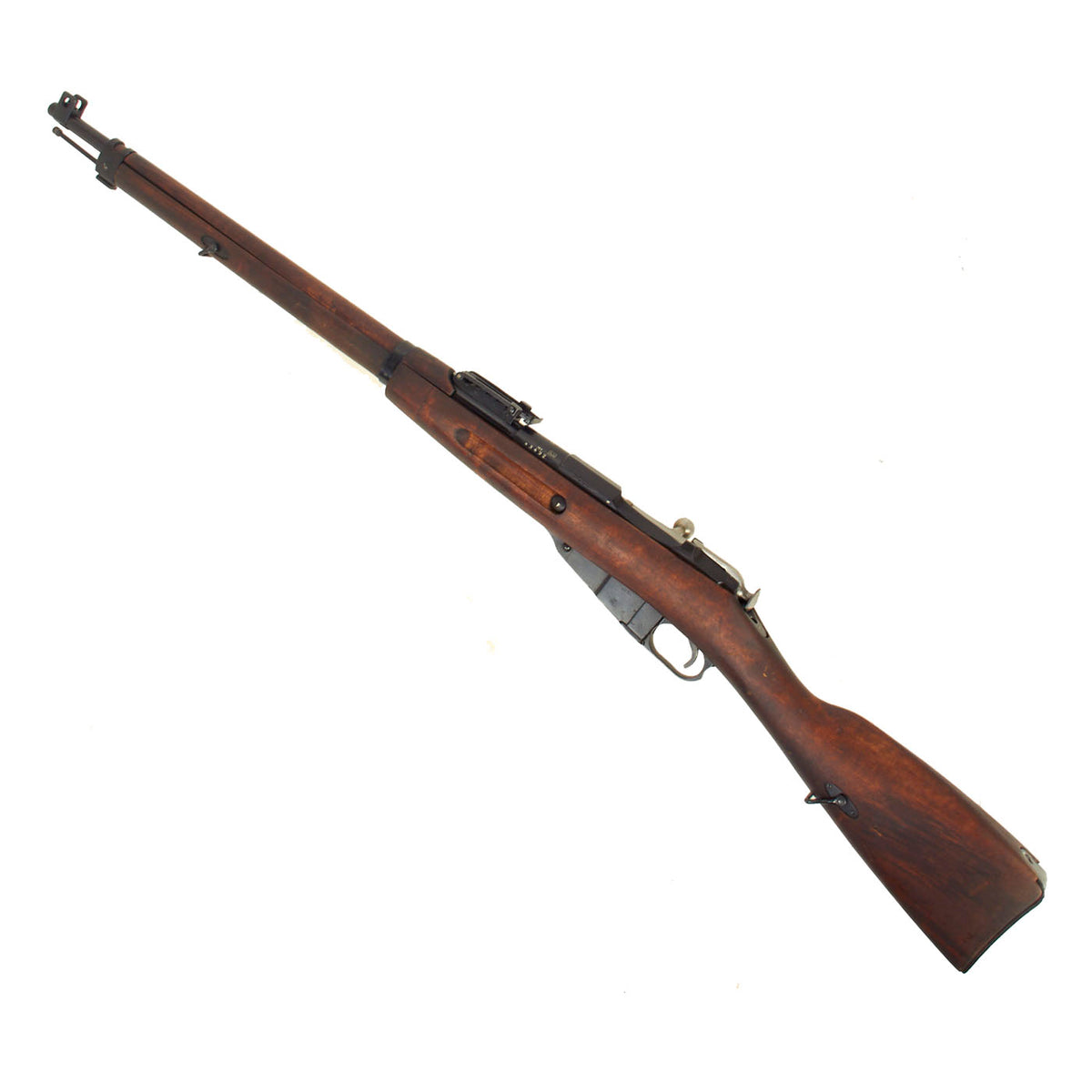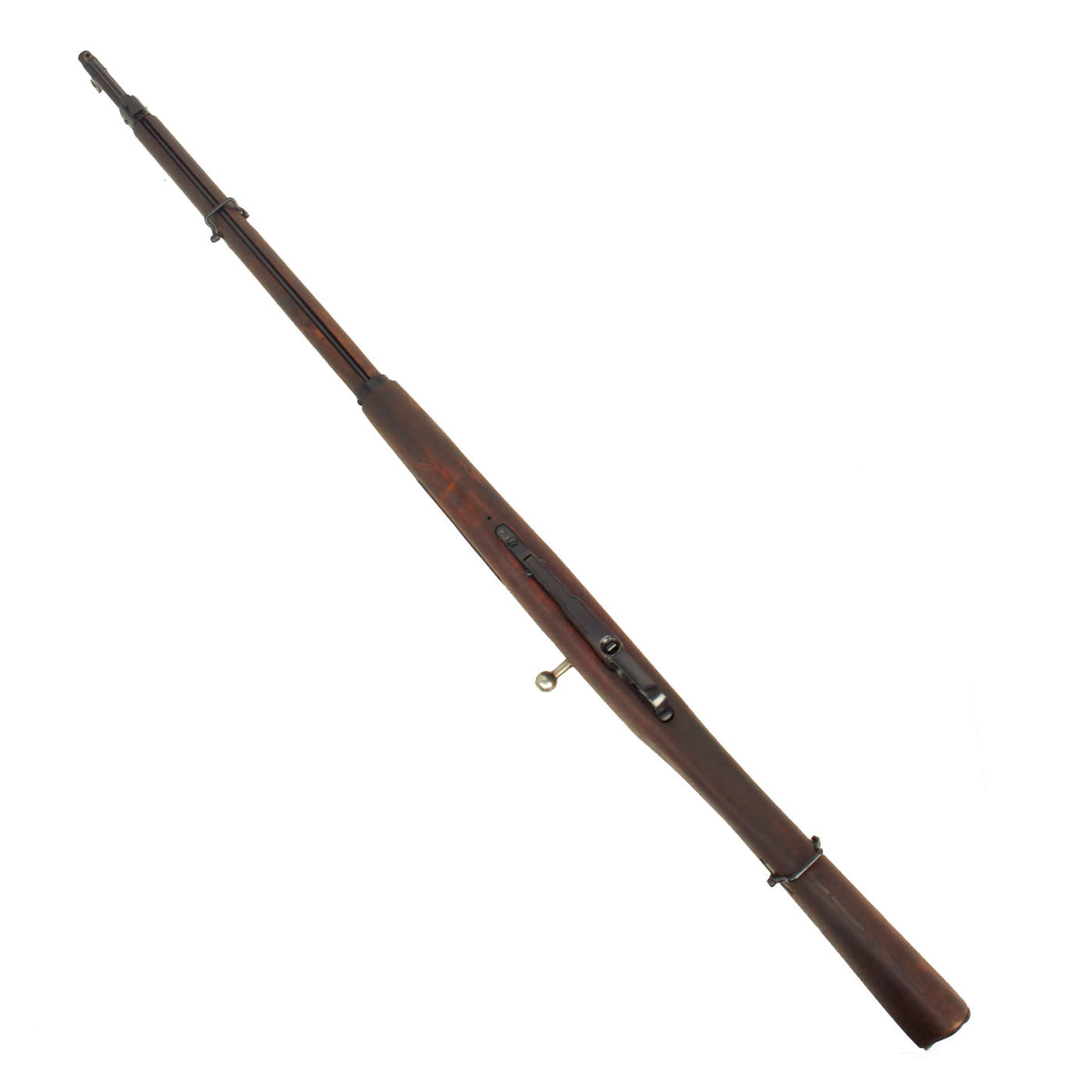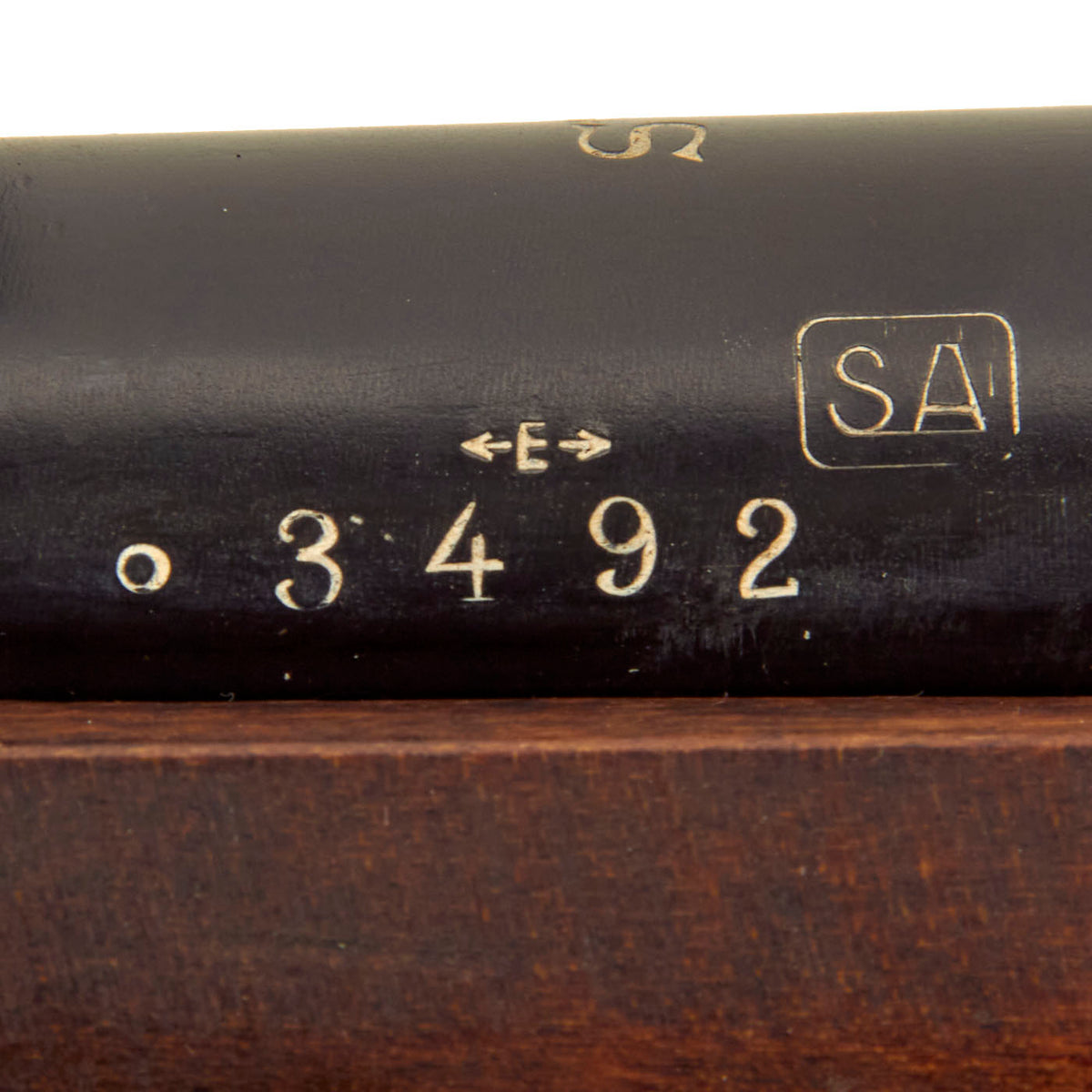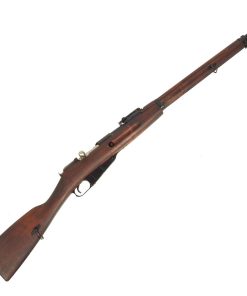Original Antique Finnish Winter War Model M/28 Mosin-Nagant Rifle Serial 3492 with SIG Barrel – Receiver Dated 1894 Original Items
$ 2.295,00 $ 573,75
Original Item: Only One Available. These are so very rare, a real pre-1899 Antique Russian Mosin-Nagant Rifle, originally referred to as the “Three Line Infantry Rifle, Model of 1891.” This example was almost certainly one of 190,000 or so Mosin-Nagant M1891 Full Length Rifles left behind in Imperial Russian depots when the country gained its independence in 1917-1918. The rifle was quickly adopted as the standard weapon of the fledgling country, and quickly the need arose to overhaul these to meet Finnish Army standards. This resulted in the first of many upgraded Finnish Mosin-Nagant rifles, the M/91. Due to the large number of rifles already present, until close to the WWII era all Finnish Mosin-Nagant rifles were built on the original Russian receivers.
The M/28 was an upgrade to the Finnish Army M/27 and the replacement for the Civil Guard’s M24. With the Finnish Army adopting the M/27, the Finnish Civil Guard, Suojeluskunta, or White Guard, took the Army’s M/27 and made some minor design changes, resulting in the M28. The rifle’s acceptance was finalized in 1928. Regardless of the barrel manufacture, all M28s were assembled in the Sako factory, Sujeluskuntien Ase-Ja Konepaja Osakeyhtio. Due to the limited numbers manufactured, loss, Finnish conversions, and the attrition rates during the Winter War, the Continuation War, and the Lapland War, the M/28 is one of the more rare variants of Finnish rifles.
Reportedly this is the rifle used by the well known Finnish sniper Simo Häyhä, nicknamed “White Death.”. Famed for its use by Finnish Ski Troopers, this rare example has all of the correct issue markings. The serial number on the left side of the receiver was lined out, and the right side of the barrel was marked with new serial number 3492, which matches that marked on the bolt. There is also a serial number marked on the right side of the receiver, added when the rifle was imported, apparently by Century Arms International, as indicated by the stamping on the underside of the barrel by the cleaning rod.
The top of the barrel is marked with the correct SY marking, indicating use by the Finnish Suojeluskunta (Civil Guard), also known as the “White Guard”. This indicates use during the “Winter War” or “Continuation War” during the WWII Era. There is also an SA inside a rectangle marking, for Suomi Armeija (Finnish Army), seen on many of these rifles, as the Civil Guard was disbanded at the end of the “Continuation War” as required by the Soviet Union. All Civil Guard arms were then turned over to the regular army, and marked as such.
The bottom of the receiver tang is dated 94 for 1894, legally classifying this as an antique. This marking surrounds an ARROW, which indicates production by Sestroryetsk or possibly Izveshk arsenal. Unfortunately there is not much information on the receiver markings used in the early days of Mosin-Nagant production. The barrel is the correct shorter 27 inch version, which is thicker than the original Russian specification for greater accuracy. It is dated with 27 in a Box for 1927 manufacture, and under the stock it is marked with the correct marking from SIG in Switzerland:
Schweiz Industrie-Gessellschaft
Neuhausen
The rear sight is an adapted Russian sight, which is numbered 1 to 8 1/2 on the right side with M indicating “meters”. However the left side is numbered instead 1 to 6, while the flip up rear sight ladder still has markings up to 3200 арши́ны (arshíny) an archaic measurement used by Russia through the first world war roughly equal to 71.12 cm. Normally the left side of the sight would be marked 1 to 12, as 12 x 100 arshíny = 8 1/2 x 100m, so we do not quite understand what measurements the sight is intended for. later M/28s would use a Finnish designed rear sight.
The stock on the rifle is the correct Finnish two part design, with a finger joint under the rear sight area, and has the cross bolt to reinforce against recoil. However the bolt is actually marked with the HAMMER proof of Tula arsenal, showing that the Finnish did not replace any parts that were still serviceable. The stock is equipped with standard sling swivels, attached to oval fittings on the stock.
Condition of the rifle is very good, especially considering the age and amount of service it must have seen. The stock is in very good condition, showing some minor repairs, however it does not look to have seen much service since it was converted to an M/28. The metalwork is equally in great shape, showing a dark blued finish overall, with markings highlighted in white to make them easier to see. It still retains the original cleaning rod, which is in good shape, though it can be difficult to remove due to swelling of the wood in the fore stock. The rifle cycles well, with a crisp dry fire. The bore is in excellent condition, with a bright finish and clear lands and grooves. There is just a bit of wear on the lands, and no fouling or oxidation to speak of.
A wonderful piece of Finnish and Firearms history! Ready to research and display!
Specifications:
Year of Manufacture: 1894
Caliber: 7.62×53mmR Finnish
Cartridge Type: Centerfire Cartridge
Length (overall): 46 3/4″ (118.7 cm)
Barrel Length: 27″ (68.6 cm)
Stock length: 43 1/4″ (109.9 cm)
Action type: Bolt Action
Feed System: 5 Round Internal
During the Winter War of 1939/1940, Finland heroically fought the forces of the Soviet Union in a David-versus-Goliath struggle that lasted about 100 days. Though the Finns eventually lost about 11 percent of their territory to the Soviet Union, they inflicted 323,000 casualties on the Soviets while suffering only 70,000 casualties themselves. Of course, for a small country that was a lot of casualties. As a result of Finland’s tenacity and courage during the Winter War, the reputation of the Finns around the world was enhanced, while the Soviet’s poor performance in combat may have contributed to AH’s decision to invade the Soviet Union less than a year and a half later.
Finland’s greatest asset during the Winter War was a large cadre of citizen soldiers who combined their skills as skiers, woodsmen and riflemen to ambush and carry out hit-and-run attacks on the Soviets. The principal weapons for the Finnish raiders were the Suomi submachine gun and the Finnish versions of the Mosin-Nagant rifle, chambered for the Finnish 7.62x53R round, which is virtually identical to the Russian 7.62x54R round used in their version of the Mosin-Nagant.
Originally, Finland had a large number of Soviet Mosin-Nagant M/91 rifles, which were in military arms depots when they achieved their independence from Russia in December 1917. Within a few years, however, the Finns would begin producing Mosin-Nagant rifles at SAKO, Tikka and Valmet, three arms producers that remain famous today for high-quality rifles.
The first large-scale upgrade of Finnish Mosin-Nagant rifles was the M/24 rifle for the Finnish Civil Guard. The Finnish Civil Guard (the Suojeluskunta) fulfilled a function similar to the U.S. National Guard. It was composed of volunteers, many of whom were outdoorsmen, hunters and shooters. They were separate from the Finnish Army, which was composed primarily of conscripts. Civil Guard members trained frequently and realistically. So much stress was put on marksmanship that the Civil Guard actually owned the Sako gun works. Most who have studied the Winter War believe that the Civil Guard was the most important element early in the conflict to slow the Russian advance. Their M/24 rifles used German barrels from Venus Arms, or barrels purchased from SIG in Switzerland. These rifles are often referred to as the “Lotta Rifle” after Lotta Svard, the women’s auxiliary of the Civil Guard, which helped raise the money for the rifle upgrades.
Next, the Finns reworked the M1891 Mosin-Nagant by retaining the receiver and magazine, but using a shorter, heavier barrel, improved sights, an improved bolt and new barrel bands, among other changes. After problems arose with the stock breaking when using the bayonet, the stocks were also modified. An interesting point is that many Finn soldiers didn’t like the bayonet, but preferred to use their traditional puukko knives for close combat. The current bayonet for the Valmet M/76 rifle is actually a knife bayonet of traditional style. A shortened cavalry version, the M/27rv, was also produced in limited numbers. Very similar to the M/27 was the M/28, which had a different barrel band and improved trigger. Initially, M/28 barrels were purchased from SIG, but later they were produced by Tikka and SAKO. All of the rifles, however, were assembled at SAKO. The major criticism of the M/28 was that it retained the Russian “Konovalov” rear sight, which Finnish troops did not like. This is one of the primary reasons for the development of the M/28-30.
Fast Shipping with Professional Packaging
Thanks to our longstanding association with UPS FedEx DHL, and other major international carriers, we are able to provide a range of shipping options. Our warehouse staff is expertly trained and will wrap your products according to our exact and precise specifications. Prior to shipping, your goods will be thoroughly examined and securely secured. We ship to thousands clients each day across multiple countries. This shows how we're dedicated to be the largest retailer on the internet. Warehouses and distribution centres can be located throughout Europe as well as the USA.
Note: Orders with more than one item will be assigned a processing date depending on the item.
Before shipping before shipping, we'll conduct a thorough inspection of the items you have ordered. Today, the majority of orders will be delivered within 48 hours. The delivery time will be between 3-7 days.
Returns
The stock is dynamic and we cannot completely manage it because multiple stakeholders are involved, including our factory and warehouse. So the actual stock may alter at any time. It's possible that you may not receive your order once the order has been made.
Our policy is valid for a period of 30 days. If you don't receive the product within 30 days, we are not able to issue a refund or an exchange.
You can only return an item if it is unused and in the same state as the day you received it. You must have the item in its original packaging.
Related products
Uncategorized
Uncategorized
Uncategorized
Uncategorized
Uncategorized
Uncategorized
Uncategorized
Uncategorized
Australian WWII Owen MK1 Machine Carbine SMG Custom Fabricated Replica with Sling Original Items
Uncategorized
Uncategorized
Band of Brothers ORIGINAL GERMAN WWII Le. F.H. 18 10.5cm ARTILLERY PIECE Original Items
Uncategorized
Uncategorized
Uncategorized
Uncategorized
Uncategorized
Uncategorized
Uncategorized
Uncategorized
